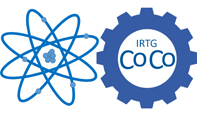08.05.2018 - Laura Cattaneo - Photoemission time delay in H2: when nuclei move as fast as electrons
| When |
May 08, 2018
from 01:00 PM to 02:00 PM |
|---|---|
| Where | HS II, Physik Hochhaus, Hermann-Herder-Str. 3 |
| Add event to calendar |
|
Photoionization dynamics of the simplest molecule H2 continues to be of strong scientific interest as new physical insight into this fundamental process can be gained [1]. Up to now, the observation of photoionization time delays into small molecules has been limited to only a few experimental studies [2-5], mostly due to the complexity of molecular targets which makes “clean” and “complete” measurements very challenging.
In this study, we investigate the dissociative ionization of H2 molecule, i.e. H2->->H+H++e-. We examine if the photoionization dynamics is influenced not only by electron correlation due to the presence of autoionizing states, but also by nuclear dynamics which takes place at comparable time scales as the electron dynamics.
This investigation has been carried out exploiting the XUV pump/IR probe RABBITT interferometric technique combined with a coincidence detection using a COLTRIMS apparatus [6, 7]. This allows us to reconstruct the kinematics of the complete reaction, as the neutral H-fragment is reconstructed according to the total momentum conservation principle, retrieving the H2 molecular frame orientation at the moment of ionization. Following the selection rules, we can further determine the final state of the photoemitted electrons.
In particular, we clearly observed variations of ionization delays as a function not only of photoelectron kinetic energy but also of nuclear kinetic energy, which implies that whenever light atoms are involved in the molecular ionization process, the outgoing electron wave packet cannot be disentangled from the nuclear wave packet. These experimental results are confirmed and complemented by a complete ab initio theoretical study incorporating not only the electronic, but also the nuclear coordinates in the description of the molecular wave function.
References:
1. Sansone, G., et al., Electron localization following attosecond molecular photoionization. Nature, 2010. 465(7299): p. 763-U3.
2. Haessler, S., et al., Phase-resolved attosecond near-threshold photoionization of molecular nitrogen. Physical Review A, 2009. 80(1).
3. Huppert, M., et al., Attosecond Delays in Molecular Photoionization. Phys Rev Lett, 2016. 117(9): p. 093001.
4. Calegari, F., et al., Ultrafast electron dynamics in phenylalanine initiated by attosecond pulses. Science, 2014. 346(6207): p. 336-339.
5. Beaulieu, S., et al., Attosecond-resolved photoionization of chiral molecules. Science, 2017. 358(6368): p. 1288-1293.
6. Dörner, R., Mergel, V., Jagutzki, O., Spielberger, L., Ullrich, J., Moshammer, R. & Schmidt-Böcking, H. , Cold target recoil ion momentum spectroscopy: a ‘momentum microscope’ to view atomic collision dynamics. . Phys. Rep. , 2000. 330: p. 95-192.
7. Sabbar, M., et al., Combining attosecond XUV pulses with coincidence spectroscopy. Review of Scientific Instruments, 2014. 85(10).
See poster.


